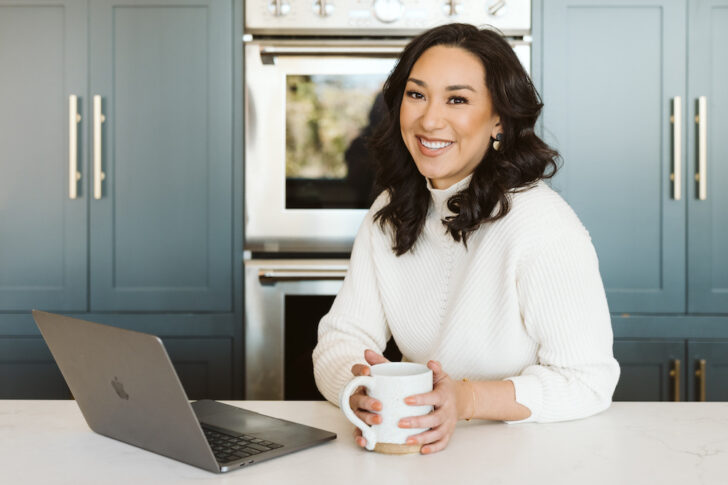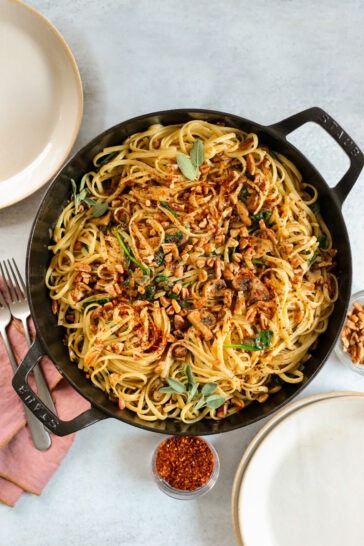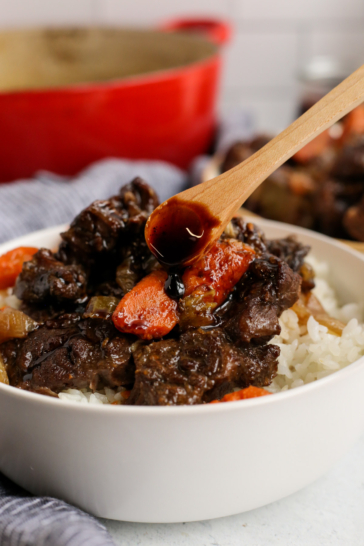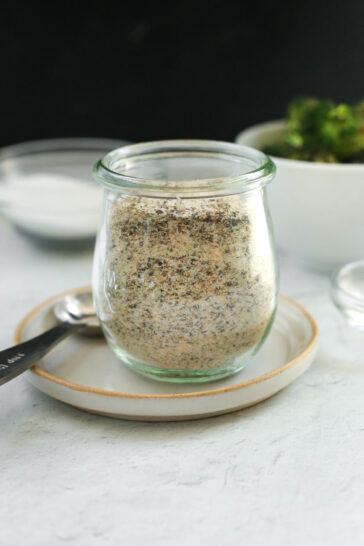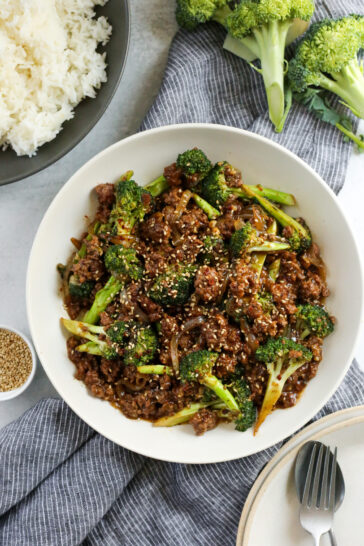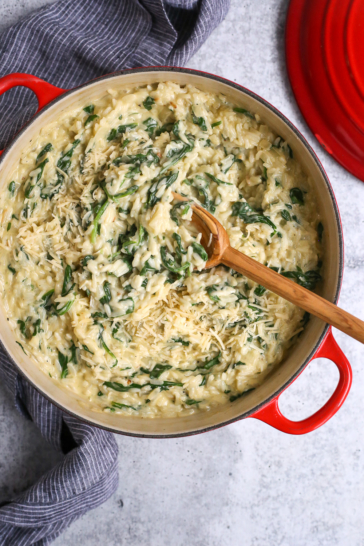Sustainability and nutrition intersect in important ways. As a dietitian who cares deeply about people, animals, and the planet, I’m passionate about learning as much as I can about where our food comes from. Read more to see what I learned during a recent trip to answer some of my questions about sustainable nutrition.

Disclosure: This post is sponsored by BASF, who hosted me for a greenhouse tour and farm visit in North Carolina. I was compensated for my time, and as always, all opinions are my own.
The day I visited Rob Fleming’s farm in Halifax County, North Carolina brought the most rain I’d ever encountered during a farm tour. Luckily, I came prepared by packing my favorite rain jacket and waterproof boots. Although the weather forced a change in plans, it didn’t put a damper on Rob’s willingness to give me an inside look at how he grows peanuts, stevia, soybeans, and cotton.
The way I ended up on this farm is not unlike the ways I end up on other farms; my work in nutrition communications often introduces me to people who are intimately connected to growing the food we eat. Over the past several years, I’ve been invited to attend several Dinner is Grown events hosted by BASF for dietitians and members of the media so we can talk face-to-face with farmers from across America. The meals are about as farm-to-table as you can get, with one of the more memorable courses from the first event featuring strawberries and sweet potatoes grown by a farmer sitting just a few seats away from me as I enjoyed each bite.
With the onset of Covid, these events moved to a virtual setting. Technology, however, could only get us so far in bridging the gap between knowing where food comes from, and really understanding the complexity of what it takes to produce it. By the time September 2021 came around, I was beginning to travel for work again. When I got the invite to come out to North Carolina to see harvest firsthand, I jumped at the chance to continue the conversation.

My first stop was the new Center for Sustainable Agriculture on the campus of BASF Agricultural Solutions’ North America headquarters in Research Triangle Park, NC. In the future, this might be the site of another delicious meal with farmers who grew the ingredients, but for now, it’s a brand new educational hub. Interactive technology shows up in various stations throughout. Future visitors will be able to craft their own experience as they learn about seed science, biotechnology, and other technologies driving sustainability practices on farms and beyond.
My tour continued into one of the large greenhouses on site. At any given time, multiple experiments are underway to determine a particular plant’s ability to withstand pests like insects, disease, and other threats plus the chemical applications used to treat them. Below you can see new and better soybean varieties being grown.
Stepping into this greenhouse felt like strolling across the surface of the sun. The immersive bright lights and white walls were a shock to my eyes on such an overcast day, and I immediately knew why the lab techs were all wearing sunglasses!

There are a lot of advantages to using greenhouses like this one for developing improved plant varieties. By optimizing growing conditions, plant scientists are able to control as many variables as possible while they focus on isolating one trait at a time. If they’re testing for a soybean plant’s ability to repel a specific insect for example, it helps if they don’t have to worry about things like too much moisture in the soil or how much light it gets. We do something similar with nutrition, in that researchers try to control for as many variables as possible when designing a trial or experiment.
It can take over 10 years for a new seed variety to make its way to market. In other words, a lot of time, money, and testing is invested before anything ever goes into the ground to grow something you or I might eat. The first few years are mostly in greenhouses like the one I saw. Then field trials begin and potentially improved seeds are put to the test against the elements of the real world. By the time it’s all said and done, the average cost of developing something like a new GMO or GE seed for soybeans, cotton, or corn is about $130-150 million.

The process looks different for vegetable seeds, organic seeds, and any other category of commercially developed seed. But the common thread is that farmers face a lot of pressure when they’re trying to grow plants of any kind from these seeds. Whether it’s drought or flooding, too hot or too cold, organic farming practices or otherwise, farmers have to juggle the need to be environmentally sustainable for the planet and financially sustainable for themselves. GMOs (genetically modified organisms), hybrids, conventional, and heritage seeds can all have a place in a food system that’s striving for those same goals, and farmers need the ability to choose the option that’s best for their operation and that can meet consumer demands.
As Kurt Boudonck, a BASF greenhouse group leader, explained, genetic engineering for an insect-resistant soybean plant allows us to expedite a process that may take thousands of years without human interference (if ever). At the same time, it gives seed scientists the highest degree of control and precision possible all along the way. And the end result could allow a farmer to drastically reduce the number of pesticide applications sprayed for a more effective result.
A lot of my clients, fellow dietitians, and other people in food and healthcare are wary of GMOs. And I can certainly empathize because I used to be one of them. Before I took the time to better understand what was happening, I had a lot of mistrust for what felt like an unnecessary amount of tampering with something I’d potentially be eating. I fell into the trap of thinking anything with “chemicals” must be bad for us. Spoiler: there are chemicals in everything, and the dose makes the poison. I also discounted the potential good new technology or innovations can do for things I care about, like the environmental impact of growing enough food for everyone. And that’s why I paid Rob Fleming a visit the following day.
We spent the morning deep in conversation, just a few feet away from a cotton baler that was in the shop for some pre-harvest maintenance. Rob walked me through the history of his farm, his family, and his recent decision to take a risk with a new crop: stevia. Although there wasn’t much to see at the time, I got my first glimpse into how much plays into a farmer’s decision on whether or not to grow a crop on their land. In this case, it involved:
- Customer demand. Stevia is much more popular than it used to be as a non-nutritive sweetener. You’re most likely to see it in a granule or powder form, either as whole-leaf stevia, a stevia extract called Reb A (a type of glycoside that’s naturally occurring in the plant), or as a blend with another sweetener. But no one else was growing stevia in the United States at the time so it all had to be imported.
- Land use. The acres where Rob now grows stevia used to be planted with tobacco – although Rob never grew the crop himself. As tobacco acres decline in eastern North Carolina, Rob’s hopeful that stevia can replace those acres with a healthier choice.
- Diversification. A lot of people I talk with imagine large farms that grow only one type of crop. In my experience, including on the Fleming brothers’ farm, this couldn’t be further from the truth. Adding a crop like stevia to an existing mix of peanuts, soybeans, and cotton was a no-brainer for someone like Rob who wanted to increase both the biodiversity and financial diversity on his farm.
- Climate. According to Rob, both the climate and soil type in this region of North Carolina were similar enough to other parts of the world where stevia thrives. It originated in South America and is now mostly grown in China, Kenya, and South American countries like Paraguay, Uruguay, and Brazil.
Of course, this is a non-exhaustive list but as you can probably tell, it’s far from being a simple endeavor. It’s also too simple to just say, “Hey stevia is great and it might grow well here, let’s start growing a lot of it!” When it comes to sustainability and nutrition, it’s never just about the growing of a crop and the nutrition or health benefits it can offer. It’s also about the inputs like transportation, processing, packaging, storage, distribution, and more. At this point, the best option for Rob to process his stevia into a high-quality product is to literally ship it across the world and back again, as the processor he uses is located in China.

My visit to this farm continued to broaden my sense of what sustainability looks like in practice for farmers like Rob. When we finally caught a break from the torrential downpour, we quickly made our way to one of his cotton fields.
Why would a dietitian care about cotton? After all, it’s not exactly edible straight from the field. But it shows up in a number of ways, and you probably interact with it more than you think. Cotton is woven into the canvas bags I use when I go to the grocery store or farmer’s market. It also shows up in my coffee filters, my favorite college-era t-shirts, and the textiles in my furniture. And byproducts of cotton, like the seeds, can be pressed into oils for cooking and food manufacturing or used to feed livestock like dairy cows.
As Rob and I strolled through his field of cotton (which was directly across from row upon row of peanuts that had been freshly dug for harvest just a few days prior), he pointed out something else to me. Can you spot it in this picture?

Tiny shoots speckled the dirt between the rows, and although they weren’t covering much of the ground at that point, they represented Rob’s efforts to use cover crops. Hint: if you haven’t spotted them yet, look directly to the left of the open cotton boll. The cover crops show up as small green clovers or seeds that haven’t germinated yet.
Farmers like Rob use cover crops to either reduce or eliminate the need to till their fields. Tilling practices were common for many years. But eventually, our understanding of soil health and erosion got to the point where it was clear that tilling can damage the fragile mini-ecosystem of the soil. Churning up dirt and exposing it to oxygen, sunlight, wind, and other elements hurled by Mother Nature makes it harder for beneficial microbes and other organisms to support healthy crops. And on this farm, they really put on a show; when it comes time to apply cover crop seeds to a field, they get dropped by an airplane, cropduster style!
When Rob and I turned our attention to the peanut field opposite the cotton, he shared how the trials of the Covid-19 pandemic impacted his crops. In any other year, a large percentage of his peanuts would have been roasted, bagged, and sold at MLB baseball stadiums across the country. But with the postponement of an entire season and no fans lining up at concession stands, he had to quickly scramble to figure out another market for his peanuts. Since many of us were staying home, peanut butter consumption was trending up and he was able to divert what he had harvested into a different supply chain. This story was an important reminder of how resourceful farmers have to be, even after their cops are out of the ground. I can’t imagine looking at nearly a year’s worth of hard work and imagining it all going to waste. But that’s a reality many farmers could face in a business full of risks.
As the rainclouds returned and a sprinkle threatened to turn into another downpour, Rob and I made our way back to his truck. Along the way, he invited me to reach down and snack on as many raw peanuts as I wanted. This wasn’t my first time tasting an unroasted peanut – I previously sampled them on a peanut farm near Austin, Texas a few years ago – but it reminded me how easy it is to take our food for granted. I rarely have to think twice about ordering a bag of peanuts at the ballpark or plucking a canister from a grocery store shelf. I have to consciously remind myself to remember the story behind those roasted, salty snacks and picture a farmer like Rob who made it possible for me to taste the fruits of their labor.
I left North Carolina with a lot more knowledge than I had when I arrived. And you know what they say about knowledge and power. Information like this helps me make empowered decisions about what and how I eat. If you’ve been following me and my work for any amount of time, you know I’m all about fearlessly nourishing meals. It’s such a privilege to be able to see firsthand where my food comes from and talk with a farmer. I know not everyone has opportunities to do that, so it’s also a privilege to be able to share my experiences with you through the screen you’re reading this on.
Thank you for reading and coming along with me on this journey to explore how sustainability and nutrition intersect. I’ll list some of the resources I thought were worth sharing below. If this topic is at all intriguing to you and leaves you hungry for more, you can learn about some of my other experiences on farms in these posts:
- Where Does Food Come From? Kansas Agriculture and the #FarmFoodTour
- Fruit Orchards in the Pacific Northwest and Facts About Food Safety
- Fruit of the Future: How Non-Browning Apples Can Solve a Food Waste Problem
